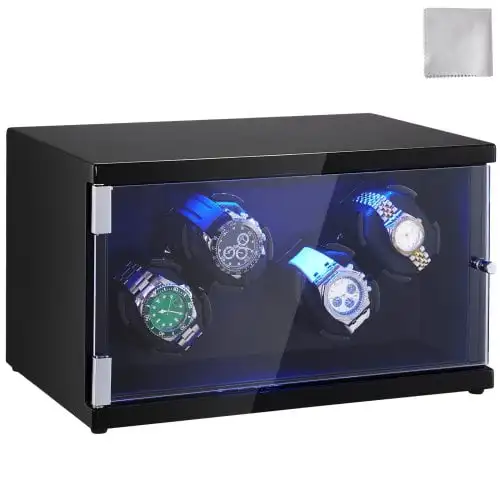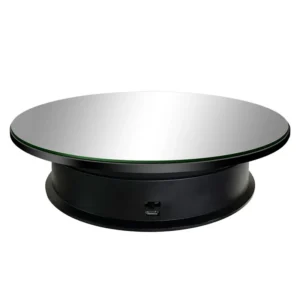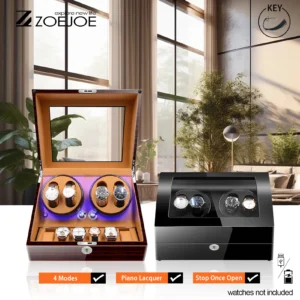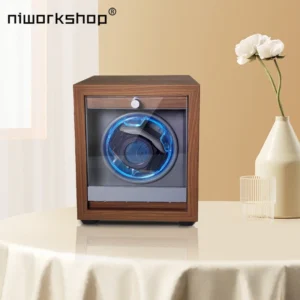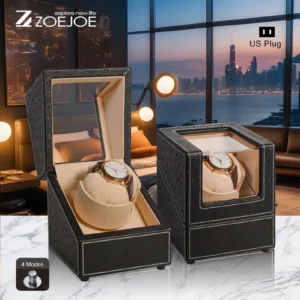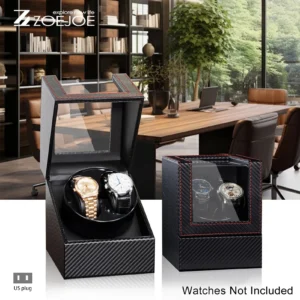Understanding Watch Winder Settings and Their Importance
Watch winders are specialized devices designed to keep automatic watches running when they’re not being worn. These ingenious mechanisms simulate wrist movements, ensuring your timepiece remains wound and ready for use. While they offer convenience, using the correct settings is absolutely critical for maintaining your watch’s health and performance.
Two primary settings determine how effectively a watch winder works:
- Direction of rotation – clockwise, counterclockwise, or bi-directional
- Turns Per Day (TPD) – the number of rotations completed in 24 hours
Getting these settings wrong can lead to serious consequences:
- Over-winding: Excessive tension in the mainspring that stresses internal components
- Under-winding: Insufficient power to keep accurate time or maintain function
- Movement damage: Unnatural rotation that contradicts the watch’s design
Automatic watches are engineered to be worn daily, with power reserves typically lasting 36-72 hours when fully wound. Without proper winding, your timepiece won’t just stop – its lubricants may settle improperly, potentially leading to long-term damage.
This guide will help you navigate the complexities of automatic watch winder programming settings to ensure your timepiece receives optimal care. Whether you’re new to watch winders or seeking to refine your approach, understanding these settings will protect your investment for years to come.
The Science Behind Automatic Watch Winding
How Automatic Movements Work
At the heart of every automatic watch is an intricate system centered around energy conservation. Unlike manual watches that require hand-winding, automatic watches feature a semi-circular metal weight called a rotor that pivots with wrist movement. This rotor is connected to a series of gears that wind the mainspring, storing energy to power the watch.
The Rotor and Mainspring Relationship
When you wear your watch, everyday arm movements cause the rotor to spin, gradually tightening the mainspring. This ingenious design means your watch essentially “charges” throughout the day as you move naturally. The mainspring serves as an energy reservoir, slowly releasing power to drive the watch’s hands and complications.
Natural Movement Translation
Your wrist doesn’t move in consistent patterns – it experiences sudden accelerations, gentle rotations, and periods of rest. Quality automatic movements are designed to harness energy from this unpredictable motion. The rotor might make partial rotations or complete turns depending on your activity level.
How Watch Winders Simulate Natural Movement
Watch winders recreate these movements through programmed rotation patterns. However, they can’t perfectly mimic the random nature of human movement, which is why proper settings are crucial. The how program watch winder setup guide details this process thoroughly, explaining how to match winder settings to your specific timepiece.
Movement Variation Between Brands
Different watch manufacturers design their movements with unique winding mechanisms. Some are more efficient, requiring fewer rotations to achieve full power. Others use specialized rotor designs that respond better to certain directional movements. These variations explain why automatic watch winder settings must be tailored to specific watch models rather than using a universal approach.
Decoding Winding Directions: CW, CCW, and Bi-directional
Understanding rotation direction is fundamental to proper watch winder usage. Let’s explore the three primary options and their applications:
Clockwise (CW)
- Rotation moves in the same direction as the hands of a clock when viewing the watch face
- Required by specific movements designed to wind only when the rotor turns clockwise
- Common in certain Swiss and Japanese movements
- Often identifiable by the rotor’s one-way bearing design
Counter-Clockwise (CCW)
- Rotation moves opposite to the hands of a clock when viewing the watch face
- Essential for movements engineered to wind exclusively in this direction
- Typical in certain vintage watches and specific modern movements
- Some watchmakers choose this direction based on movement architecture
Bi-directional
- Combines both clockwise and counter-clockwise rotation
- Ideal for watches that wind in both directions
- Most common in modern automatic watches
- Maximizes winding efficiency by utilizing all rotor movement
- Often the safest choice when specific direction is unknown
The direction requirement stems from the internal gearing system connected to the rotor. Some movements contain a clutch mechanism that only engages in one direction, while others can harness energy from rotation in either direction.
When determining direction, always visualize yourself looking at the watch face directly. This perspective ensures you’re correctly identifying clockwise versus counter-clockwise motion.
Understanding watch winder rotation modes comparison helps collectors make informed decisions, especially when managing diverse watch collections with different requirements. Quality rotating watch holder systems typically offer all three directional options to accommodate various movement designs.
Understanding Turns Per Day (TPD) Settings
Turns Per Day (TPD) represents how many complete rotations your watch winder performs in a 24-hour period. This critical setting directly impacts how much energy transfers to your watch’s mainspring.
Most automatic watches require between 650 and 1,800 TPD to maintain optimal power. This range varies based on several factors:
- Movement design: Different calibers have varying winding efficiency
- Power reserve capacity: Watches with longer power reserves often need fewer turns
- Rotor construction: Some rotors wind more efficiently than others
- Age of movement: Older movements sometimes require additional rotations
The relationship between TPD and power reserve is straightforward but crucial. A watch with a 40-hour power reserve needs enough daily rotations to maintain that reserve without exceeding it. Getting this balance wrong leads to problems:
- Too high TPD: Potential overwinding, excessive wear on components, and wasted energy
- Too low TPD: Insufficient power accumulation, causing the watch to stop or lose accuracy
- Inconsistent TPD: Unpredictable power reserves and potential timing issues
Finding the optimal TPD involves understanding your specific watch’s requirements. The goal isn’t maximum rotations but rather the minimum needed to maintain consistent power. The watch winder TPD settings guide provides detailed information for achieving this balance.
Many luxury watch winder systems feature adjustable TPD settings, allowing fine-tuning for different timepieces in your collection. This adaptability is essential for collectors with diverse watches, each with unique winding needs.
Comprehensive Watch Winding Settings Database
This database provides recommended settings for popular watch brands and movements. Use these specifications as starting points, recognizing that individual watches may perform optimally with slight adjustments.
Rolex Movements
| Model/Movement | Recommended TPD | Direction |
|---|---|---|
| Caliber 3135 | 650-750 | Bi-directional |
| Caliber 3235 | 650-750 | Bi-directional |
| Caliber 3255 | 650-750 | Bi-directional |
| Caliber 4130 (Daytona) | 800-900 | Bi-directional |
| Vintage Models | 650-800 | Bi-directional |
Omega Calibers
| Movement | Recommended TPD | Direction |
|---|---|---|
| Caliber 8500/8900 Series | 800-900 | Bi-directional |
| Caliber 1120 | 800-850 | Bi-directional |
| Caliber 2500 | 800-850 | Bi-directional |
| Caliber 3300 Series | 850-950 | Bi-directional |
| Co-Axial Movements | 800-900 | Bi-directional |
Seiko Automatic Movements
| Movement | Recommended TPD | Direction |
|---|---|---|
| 4R Series | 650-850 | Bi-directional |
| 6R Series | 650-850 | Bi-directional |
| 7S Series | 650-800 | Bi-directional |
| 8L Series | 650-800 | Bi-directional |
| Spring Drive | 700-800 | Bi-directional |
Common ETA Movements
| Movement | Recommended TPD | Direction |
|---|---|---|
| ETA 2824-2 | 650-800 | Bi-directional |
| ETA 2892.A2 | 650-800 | Bi-directional |
| ETA 7750 (Chronograph) | 800-1000 | Clockwise |
| ETA 2836-2 | 650-800 | Bi-directional |
| Powermatic 80 | 650-800 | Bi-directional |
Miyota/Citizen Movements
| Movement | Recommended TPD | Direction |
|---|---|---|
| Miyota 8215 | 650-850 | Bi-directional |
| Miyota 9015 | 650-850 | Bi-directional |
| Miyota 9039 | 650-850 | Bi-directional |
| Citizen Caliber 0100 | 800-900 | Bi-directional |
| Miyota 82S0/82S5 | 650-850 | Clockwise |
Luxury Brand Movements
| Brand/Movement | Recommended TPD | Direction |
|---|---|---|
| Patek Philippe (Most Calibers) | 800-1000 | Bi-directional |
| Audemars Piguet (Most Calibers) | 800-950 | Bi-directional |
| Jaeger-LeCoultre | 800-1000 | Bi-directional |
| Vacheron Constantin | 800-1000 | Bi-directional |
| A. Lange & Söhne | 800-1000 | Clockwise |
Mid-Range Brand Movements
| Brand/Movement | Recommended TPD | Direction |
|---|---|---|
| TAG Heuer Calibre 5 (Based on ETA/Sellita) | 650-850 | Bi-directional |
| Longines (L888) | 650-800 | Bi-directional |
| Oris (Sellita-based) | 650-800 | Bi-directional |
| Tudor (Modified ETA/In-house) | 650-800 | Bi-directional |
| Breitling (B01) | 800-950 | Bi-directional |
Understanding watch winder settings movement type helps determine the appropriate parameters for specific watches. For deeper insight into the mechanics of this process, explore how watch winder rotation cycles work to optimize your timepiece care routine.
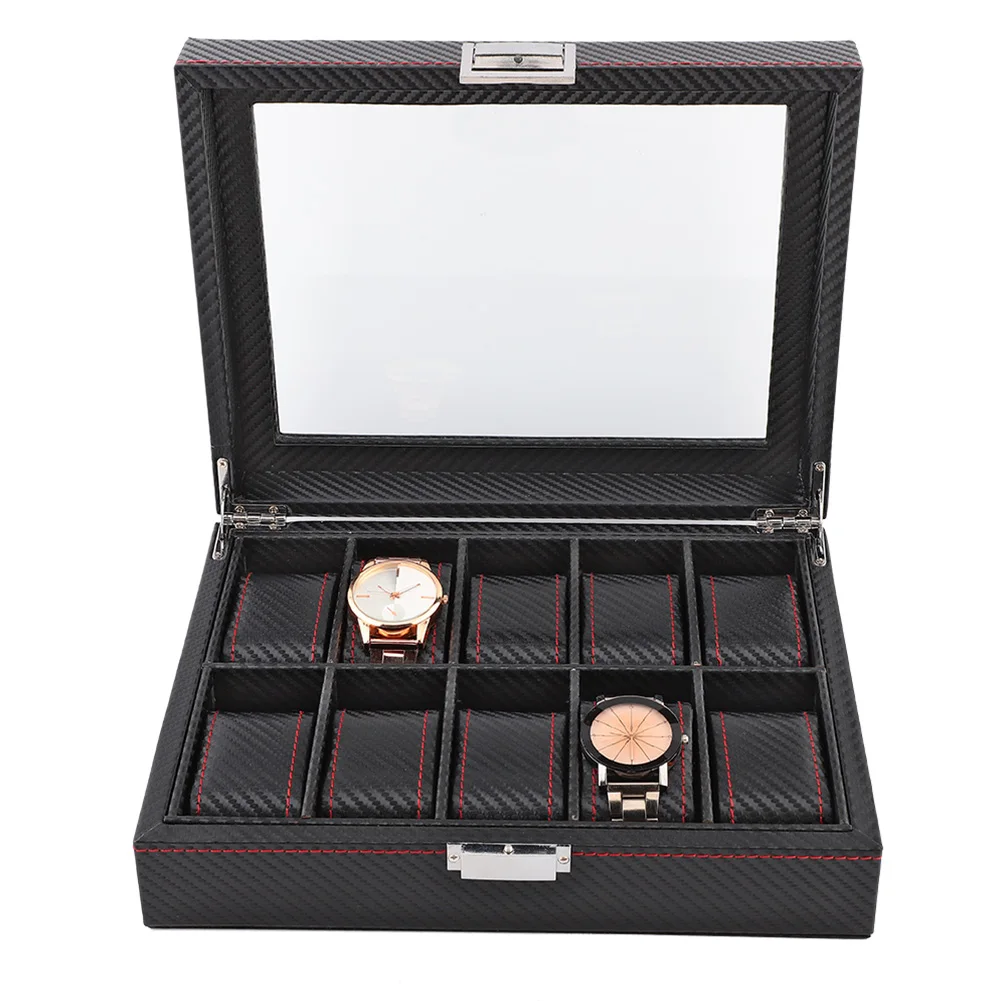
How to Find the Correct Settings for Your Specific Watch
When your specific watch isn’t listed in the database above, follow this systematic approach to determine optimal settings:
Check the manufacturer’s resources
* Consult your watch manual for recommended winder settings
* Visit the manufacturer’s official website for technical specifications
* Contact customer service if information isn’t readily availableIdentify your movement
* Look for caliber information on the watch caseback
* If not visible externally, check the warranty card or purchase documentation
* For transparent casebacks, photograph the movement and use online identification resourcesResearch online resources
* Visit watch enthusiast forums where collectors share settings
* Search movement databases that list winding directions
* Review watch winder manufacturer websites for their recommendationsSystematic testing approach
* Start with conservative settings: 650 TPD bi-directional
* Monitor power reserve over a 72-hour period
* If the watch stops before expected power reserve duration, increase TPD by 100-150
* Continue adjustments until finding the minimum TPD that maintains full power
* Once TPD is established, test directional preferences if uncertainRecord optimal settings
* Document successful settings for future reference
* Note any seasonal variations or positional preferences
This methodical approach helps determine the best automatic watch winder settings for any timepiece. For collectors with a single automatic watch, a quality single watch winder programmed correctly provides ideal maintenance without unnecessary wear on the movement.
Troubleshooting Common Watch Winder Issues
My watch stops despite being on a winder. What’s wrong?
This common issue typically stems from insufficient TPD settings. Increase your TPD by 150-200 rotations and monitor for 3-4 days. If the problem persists, check that your watch is properly seated on the cushion with the crown positioned correctly. Some watches require specific orientation to wind efficiently.
My watch seems to be running fast after using the winder.
This could indicate overwinding or magnetization. Reduce the TPD setting by 150-200 rotations. If accuracy doesn’t improve, have your watch checked for magnetism by a professional. Quality winders shouldn’t cause magnetization, but nearby electronics sometimes can.
Can my automatic watch be overwound on a winder?
Modern automatic watches contain a slipping clutch mechanism that prevents true overwinding damage. However, excessive and unnecessary winding can increase wear on this mechanism. Use the minimum TPD required to maintain power.
My watch winder makes noise during operation.
Some noise is normal, but excessive sounds may indicate issues. Check that the watch is properly secured and balanced on the cushion. If the noise comes from the winder motor, it could indicate mechanical problems requiring service. Most quality winders operate with minimal noise.
My watch’s power reserve seems inconsistent on the winder.
This could result from an inconsistent winding pattern or positional sensitivity. Try adjusting the rest period settings if your winder offers this option. Some watches wind more efficiently in certain positions, so experimenting with watch orientation can sometimes solve this problem.
For additional solutions to common issues, the troubleshooting common watch winder problems guide offers comprehensive advice for resolving these and other concerns.
Best Practices for Watch Winder Usage
Implementing these best practices ensures optimal performance and longevity for both your watches and winders:
Location matters: Place your winder away from direct sunlight, magnetic fields, and areas with temperature fluctuations. Stable environments between 68-77°F (20-25°C) with moderate humidity work best.
Understand rest periods: Many quality winders alternate between active winding and rest periods. This pattern more naturally simulates wearing patterns and prevents unnecessary stress on the movement.
Secure watches properly: Ensure your timepiece sits firmly but not too tightly on the cushion. The crown should be unobstructed and the watch balanced to prevent uneven rotation.
Regular maintenance: Dust your winder regularly and follow the manufacturer’s guidance for motor care. Similarly, watches benefit from regular professional servicing every 3-5 years.
Strategic usage: Remove watches for long-term storage or when sending for service. Not every automatic watch needs constant winding – those worn frequently can often rest between wearings.
Benefits of Using a Properly Set Watch Winder
When configured correctly, a quality watch winder delivers several significant advantages for automatic watch owners:
Optimal lubrication distribution: Continuous gentle movement ensures oils remain evenly distributed throughout the movement, preventing dry spots and ensuring smooth operation.
Always-ready convenience: Your watches remain fully wound and accurate, displaying the correct time and date when you decide to wear them.
Preservation of complicated functions: Watches with calendar mechanisms, moon phases, or other complications stay synchronized without needing frequent resetting, which can stress delicate components.
Reduced setting wear: Regular winding reduces the need for crown manipulation, minimizing wear on winding mechanisms and crown seals.
Elegant display: Beyond functional benefits, watch winders showcase your timepieces as the functional art pieces they are, enhancing your collecting experience.
Automatic Watch Winder, Luxury Watch Winder, Single Watch Box
$307.39 Select options This product has multiple variants. The options may be chosen on the product pageRotating Watch Holder, Watch Holder
Price range: $93.28 through $93.35 Select options This product has multiple variants. The options may be chosen on the product page4 Watch Winder, 6 Watch Box, Automatic Watch Winder
$512.31 Select options This product has multiple variants. The options may be chosen on the product pageAutomatic Watch Winder, Single Watch Winder, Wooden Watch Holder
$201.76 Select options This product has multiple variants. The options may be chosen on the product pageAutomatic Watch Winder, Leather Watch Travel Case, Single Watch Winder
$146.30 Select options This product has multiple variants. The options may be chosen on the product pageAutomatic Watch Winder, Double Watch Winder, Leather Watch Boxes
$147.60 Select options This product has multiple variants. The options may be chosen on the product page
The proper care of luxury timepieces extends their lifespan significantly. Mechanical watches are designed to run, and careful winding maintains their precision and mechanical integrity for generations.
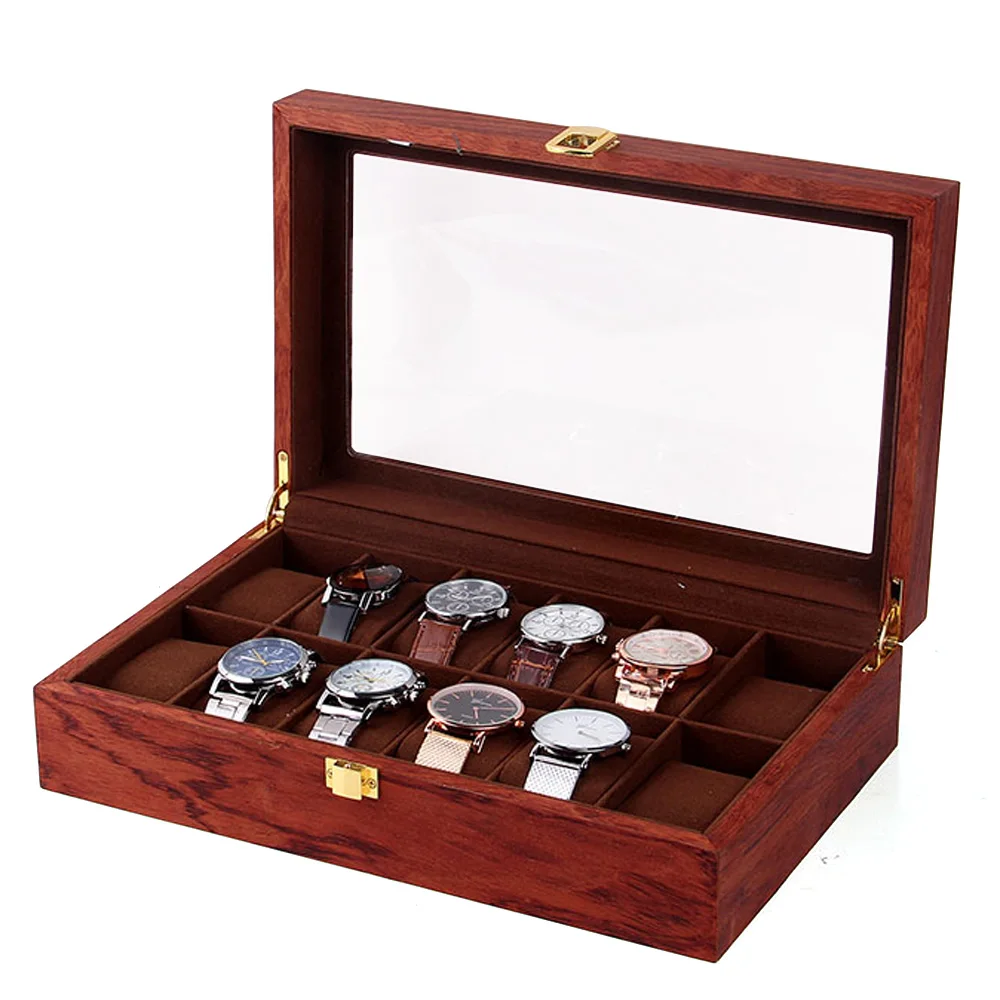
Frequently Asked Questions About Watch Winder Settings
Can a watch winder damage my watch?
A properly configured watch winder won’t damage your timepiece. However, incorrect settings (particularly excessive TPD) may cause unnecessary wear. Using the minimum effective settings provides optimal results without strain.
Do all automatic watches need winders?
Not necessarily. Watches worn daily usually maintain sufficient power naturally. Winders are most beneficial for watches worn in rotation, those with complicated functions that are difficult to reset, or collections where constant readiness is desired.
How long can I leave my watch on a winder?
Most modern watches can remain on properly configured winders indefinitely. However, watches still benefit from regular service every 3-5 years regardless of winder usage.
Should I manually wind my watch before placing it on a winder?
For best results, give your watch 10-15 crown winds before placing it on a winder. This provides immediate power while the winder begins its work, ensuring continuous operation.
Can I use a watch winder for vintage timepieces?
Exercise caution with vintage watches. Many older timepieces lack the protective mechanisms of modern watches and may have degraded lubricants. Consult a specialist before placing valuable vintage pieces on winders.
Do winders with higher TPD settings offer better performance?
No. The optimal TPD is the minimum required to maintain your watch’s power reserve. Higher settings don’t improve performance and may cause unnecessary wear.
Is bi-directional always better than single-direction winding?
Not necessarily. While bi-directional winding works for most watches, some movements are engineered for specific directional efficiency. Always match the winding direction to your specific movement design for optimal results.
Understanding guide watch winder compatibility helps ensure your specific timepiece receives appropriate care based on its unique design characteristics.
Watch Winder Features to Consider When Making a Selection
When selecting a watch winder, prioritize these key features based on your collection’s needs:
Programmable TPD settings: The ability to adjust turns per day ensures compatibility with various watch movements. Look for winders offering ranges from 650-1,900 TPD for maximum flexibility.
Direction control options: Quality winders should offer clockwise, counterclockwise, and bi-directional rotation modes to accommodate all movement types.
Power source reliability: Consider both battery-operated models for placement flexibility and AC-powered options for continuous operation without battery changes.
Motor quality: Silent, smooth motors indicate good construction and promote longevity. Lower-quality motors often produce noise and may have shorter lifespans.
Cushion design: Adaptable cushions that accommodate different watch sizes and bracelet configurations ensure proper fit and effective winding.
Additional storage: Models with drawer space or display compartments maximize utility, especially for collectors with both automatic and quartz timepieces.
Understanding optimal watch winder settings helps inform your purchase decision, particularly when considering double watch winder options for growing collections.
The right winder combines these features with quality construction to provide years of reliable service for your treasured timepieces. Daily Accents offers premium solutions that prioritize proper watch care while enhancing the display and enjoyment of fine automatic watches.

